The Life of a Scientist: Traveling to ACM 2012, Niigata, Japan
- By Christina Richey
- July 12, 2012
- Comments Off on The Life of a Scientist: Traveling to ACM 2012, Niigata, Japan
The 2012 Asteroids, Comets, Meteors (ACM) Conference, was held mid-May in Niigata, Japan. The conference brought together approximately 400 scientists from over 30 countries to present observational, experimental, and theoretical results on small bodies (see the group photo below). I presented my experimental work on metal-silicate dust grain analogs and discussed with colleagues astrophysical implications of my laboratory results in preparation for our upcoming publication.
Other work that was presented included several sessions on results from the Dawn Spacecraft’s mission to Vesta, the Japanese (Hayabusa-Itokawa) and NASA (Stardust-Wild 2) sample return missions, as well as planned, upcoming small body missions by the Japanese, ESA, and NASA (including New Horizons, Hayabusa-2, OSIRIS-Rex, and MarcoPolo-R). Additionally, work was presented on space-borne observations of small bodes (AKARI, Herschel, WISE, HST, etc), comet missions, meteorite falls, dynamics, compositional studies, impact processing, surface processing and geology, origins and astrobiology of small bodies, and even human exploration of Near Earth Objects (NEOs). Basically, if you were a scientist who cared about small bodies in our solar system, this was the place to be, and it was a highly productive conference.
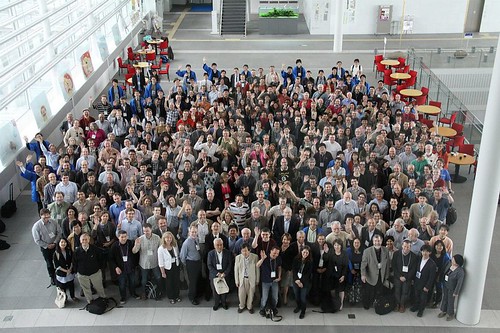
A group photo from ACM 2012. Image courtesy of the ACM conference.
One of the major highlights of the conference was the mission results from the Dawn Mission’s study of Vesta. Vesta is the second most massive asteroid after Ceres, and is thought to be a remnant protoplanet. The Dawn Spacecraft entered orbit around Vesta in July of 2011 and will continue to do so until late August. The Dawn Science team presented results on Vesta at ACM, including verified existence of an impact basin at the south pole, geochemical and mineral diversity, with a unique dark material, light material, boulders, and pits. Vesta is now believed by many scientists to be the last large planetoid that came together to form the rocky planets during the early formation of the solar system. Vesta is known for as the “dry” rock in the Dawn mission, with Ceres, the wet “ice” a being the next destination, which it is scheduled to reach in 2015. While previous missions were restricted to flybys, Dawn is the first spacecraft to orbit two different asteroids. In order to accomplish this feat, Dawn uses a unique ion propulsion system, which is the first NASA exploratory mission to do so. For more on the Dawn mission, please check out the mission’s website.
Another major mission presented on was the Stardust Missions’ results for Comet Wild 2, which was believed initially to contain a geologically uninteresting nucleus. However, Wild 2 shocked even the mission team, as the results indicated walls, possible craters, and even vents. Indeed, most of the geological activity discovered is unexplained at the moment. But the really interesting result (well, at least the most fascinating results to a person doing lab mineralogy) was the compositional analysis of the nucleus, which was believed to be similar to interplanetary dust particles, with mainly amorphous condensates or pre-solar grain materials. Instead, minerals discovered were crystalline, not amorphous, and some materials required high temperatures during formation. The CAIs, or calcium and aluminum-rich inclusions, were previously only found in primitive meteorites. Also, organic species were detected. Indeed, Stardust’s results from Comet Wild 2 have changed our current perspective on the timescale and formation of comets. For more on Stardust, check out the mission website.
My personal favorite from the sessions (of course, outside of the dust work being presented) was a session on the future small body missions. This included the sample acquisition strategy for OSIRIS-Rex, as well as details on the near-Earth asteroid chosen for the sample mission, 101955, or 1999 RQ36, a nearby carbonaceous asteroid that best represents the possibility of returning a pristine samples to understand the evolution on these small bodies. OSIRIS-Rex is short for Origins, Spectral Interpretation, Resource Identification, and Security-Regolith Explorer, although I must admit, every time I say OSIRIS-Rex I can’t help but imagine a tiny dinosaur running around on an asteroid. Other sample return missions included the Japanese spacecraft Hayabusa-2, a follow up mission to the successful Hayabusa mission, which returned material from the asteroid Itokawa in 2010, and the conceptual stage spacecraft from the European Space Agency, MarcoPolo-R. Additionally, the Japanese solar power sail, which I have named the Lotus Explorer, was discussed. The explorer is planned to explore the outer solar system without nuclear technology, and is currently planned to study the Jovian Trojan asteroids in the 2020s. While still conceptual, this explorer is not only an intriguing concept technologically, but also artistically (see photo below, from the Japanese Aerospace Exploration Agency, JAXA, and courtesy of Akihiro Ikeshita), hence my nickname for the conceptual spacecraft.
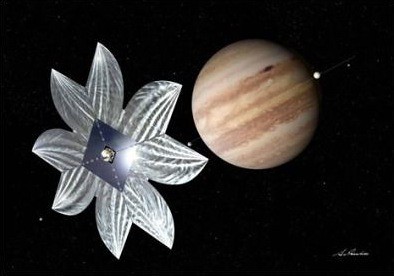
Image Credit: Japanese Aerospace Exploration Agency, JAXA, and courtesy of Akihiro Ikeshita
For more information on these missions, see:
Niigata, the capital of Niigata Prefecture, lies on the Sea of Japan. The people were extremely kind and the city was a wonderful host to a large collection of scientists from various backgrounds. The host hotel, the Hotel Nikko Niigata, was a part of Toki Messe, the Niigata Convention Center, which is where the conference was held (see the photo, below). The views from the rooms were stunning; as well as from the observation deck atop of the hotel. The seafood and rice were the best the world had to offer. I am not regularly a fan of rice, however, I had a massive bowl with every meal, and typically tons of fresh fish. And while jetlag on long trips is always rough, I quickly discovered that I was never alone walking the riverbank at 5 AM, and people were super friendly.

Toki Messe, with the Hotel Nikko Niigata and the Convention Center, where ACM 2012 was held. Credit: Christina Richey

The view of the Sea of Japan and Niigata from the observatory deck of the Hotel Nikko Niigata. Credit: Christina Richey
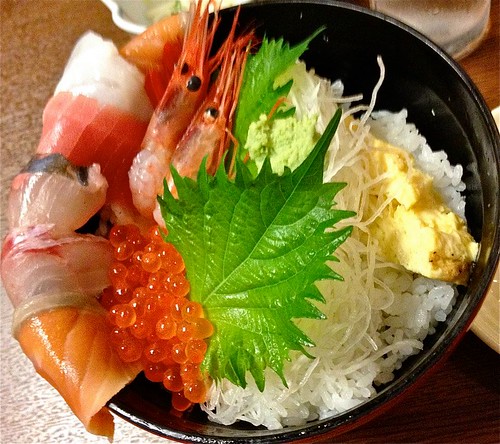
My typical dinner: rice and seafood, a locally caught and grown in Niigata. Credit: Christina Richey
I was in love with the vending machines in Japan, as you could get cold and hot beverages, and caffeine was essential when dealing with jetlag. Credit: Christina RicheyWhile science was the #1 priority on this trip, a few side moments as a tourist did occur. The first was an excursion put together by the conference to the beautiful Northern Culture Museum, which is located about 40 minutes outside of Niigata City. Niigata City is surrounded by rice paddy fields. One of the more fascinating things to me was how the people lived amongst the rice fields. The land in Japan is fully used, with large gardens in people’s back yards and soccer fields surrounded by rice paddy fields. Riding in a large bus down a narrow road, surrounded by rice paddy fields, took my breath away (mostly due to the beautiful scenery, but once or twice because I thought for sure we were going to fall in to a watery field). The Northern Culture Museum was a home of the Ito family and was built between 1885 and 1887. The mansion houses many artifacts, including Chinese sculptures and ceramics, Japanese paintings, ceramics, armor, and archaeological artifacts. The mansion includes a garden laid out in the traditional style of the 14th-15th century gardens (Kamakura Period) and several teahouses.

The Northern Culture Museum. Credit: Christina Richey
The second excursion came courtesy of jetlag. I spent one early morning riding the Japanese East Rail train (Joetsu Shinkansen) just 45 minutes out of Niigata City to a small town in the Japanese Alps called Minami-Uonuma. While the city itself is a tourist destination during the winter, as Niigata Prefecture is known as “Snow Country” for it’s heavy snowfalls, I decided to stray away from the ski resorts and onsens. Instead, I crossed the Uono River, away from the city, and explored a small portion that included a park and rice paddy fields. Surrounded by nature, and seeing three whole other people the entire time on that side of the river, was refreshing and the scenery was absolutely stunning. Revitalized, I was able to get back to the conference morning sessions and present my poster that afternoon.
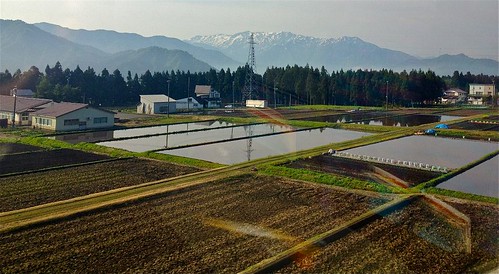
The typical landscape in Niigata Prefecture: Mountains, homes, and rice paddy fields. Credit: Christina Richey
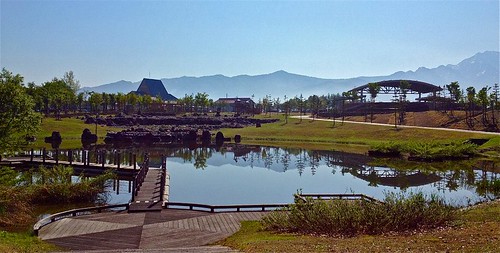
A small park in Minami-Uonuma, Japan. Credit: Christina Richey
The final trip was a very brief visit to Tokyo, which is difficult, given the city happen to be the 3rd largest in the world. Luckily, one of my childhood friends, Ty, lives in Tokyo, and she was a fantastic tour guide. It was also great to catch up with my friend, who I hadn’t seen in 10 years, yet was able to keep in contact with through some crazy moments (she lived in Tokyo during last year’s earthquake and nuclear crisis, while I lived in Birmingham, AL and watched helplessly as a tornado destroyed the western suburbs). She took me to the best spots in Tokyo: the Asakusa Temple, The Meiji Jingu Shrine, Harajuku Street, and even a cat café. And in case anyone is curious, yes, you can herd cats. (Food is the key… well, all except for that one cat that enjoys creating chaos. You’ll never control that cat.)
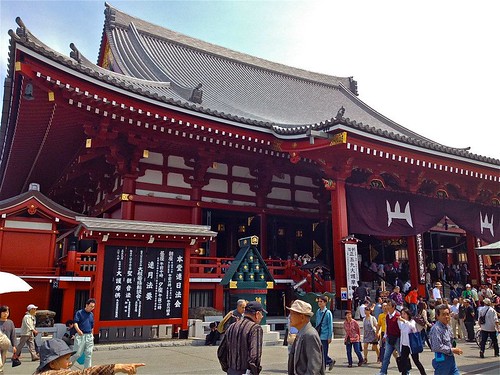
Asakusa Temple, Tokyo. Credit: Christina Richey
This blog piece could go on forever, but to summarize, Japan was the trip of a lifetime, and anyone who has the chance should go and experience a beautiful country with truly friendly people. My chance came thanks to my life as a scientist. Next trip: The NASA Nordic Summer School in Reykjavik, Iceland. Have I mentioned how much I love my job? Even though I work long hours, went to school for longer than most folks would have admitted, and am not fully cemented in a permanent position as I approach 30, I know that I am meant to be a scientist, and that I truly love my job.



